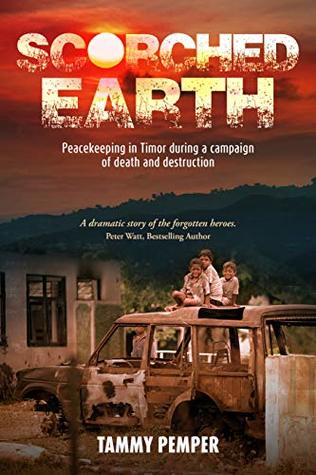Pemper has concentrated on the nineteen days in 1999 that Peter Watt was with the UN Peacekeeping Force in East Timor.

Paperback 320pp RRP $29.99
He arrived on 28th August (the eve of the Independence Referendum) and departed on the last flight carrying UN staff safely out of the country.
This was not Watt’s first role as a peacekeeper, so he knew both what was expected of him and the difficulties he faced as an unarmed civilian trying to keep separate factions hell-bent on the genocide of the Timorese. With a police force, that supposedly was to provide protection for UN staff as they conducted and oversaw the referendum, merely standing by while the local militia intimidated both them and the Timorese, mere existence became a constant battle of wits. Many police would enter their station and then re-emerge in militia uniform.
With an attitude of ‘we built it and we are not leaving it for anyone else to have’, Timorese dwellings were systematically daubed in red paint, then looted by both militia and police before being torched. UN compounds became safe havens for the persecuted Timorese despite there being no way to secure or defend the compounds This placed incredible strain on resources and hampered the UN staff in their essential tasks. The collection of ballot boxes from outlying stations and securing them in the UN headquarters in Dili became a deadly game of cat-and-mouse as UN staff and vehicles ran the gauntlet of militia units and their roadblocks.
The reaction of the militia on hearing (on 4th September) that 78% had voted for independence was to increase the tempo of their revenge killings and intimidations as the UN took steps to plan the evacuation of staff and a few Timorese. Some staff became dejected at the thought of abandoning the Timorese at the time they most needed their support. The tales of Indonesian atrocities and Timorese sufferings became more violent as the day of final evacuation (15th September) approached. Already refugees who had fled to West Timor had commenced returning to their beloved country despite the incredible risks they faced.
Told through the eyes of Watt, the narrative moves non-stop at break-neck speed. His personal feelings and reactions to events complement the historical telling. There is an expansive array of coloured photographs of Aug-Sep 99, and another of Watt’s subsequent visits in the last 20 years. A concise epilogue encapsulates events from the insertion of the UN’s INTERFET force on 20th September 1999.
There has been no ‘laundering’ of events in this account which Semper has fastidiously researched and tells it as it happened and is comfortable in ‘naming names’. Compare this with the delays caused by the Department of Foreign Affairs and Trade trying to censor the first volume of the official history of Australia’s peacekeeping operations in East Timor [as reported in The Sunday Age, 10th November 2019].
Reviewed for RUSIV by Neville Taylor, December 2019
Contact Royal United Services Institute about this article.






